Have you ever been on a cave dive and found yourself mesmerized by the variety and beauty of cave formations?
I absolutely love seeing all those amazing shapes and forms but I appreciate them even more now that I understand how they were formed and what a long process it is. Without being a scientist, I did some research and tried to learn as much as possible about the environment I dive into on a daily basis. I put together a short guide to the cave geology basics as an aid for our students and everyone interested in the topic. I hope it will help you to understand better the environment you dive in and value its conservation.
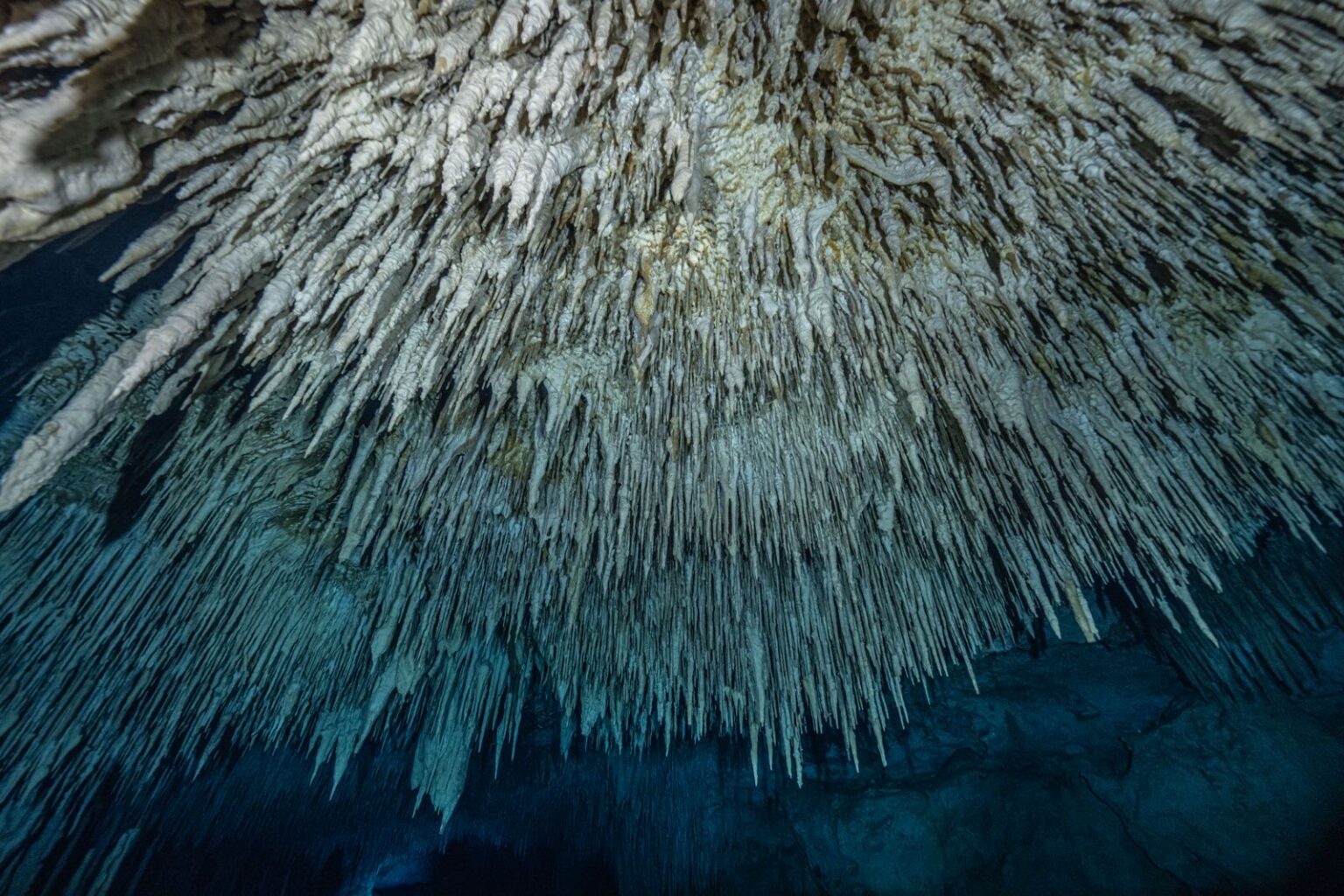
Cave Types
There are many cave classifications and caves can form by a variety of processes. To simplify, let’s categorize them into a few big groups.
Volcanic caves, like lava tubes, formed by flowing lava and the effects of volcanic gas. Volcanic caves are formed around the volcanos and are easily destroyed by erosion. They are found in recent lava flows that are less than 20 000 000 years old. A lava tube forms when lava flow cools and hardens on the surface while inside the lava keeps flowing at 1,200°C. When the volcano eruption stops so does the lava flow, leaving a hardened tube. If the tube was formed close enough to the ocean, the saltwater then filters through the rock, creating flooded caves. In some instances rain water from the surface does the same, filling lava tubes temporarily or permanently.
Tectonic caves are formed by the movement of the bedrock. Although tectonic caves can be formed by any geologic force that causes rocks to move apart, the key mechanism is gravity sliding. The optimum setting for the development of tectonic caves happens where massive rocks dip gently to the sides of the edges of mountains. Those massive rocks split and separate, forming vertical fractures that could be quite narrow. If they separate too much and the roof collapses, it creates canyons.
Next on the list are caves formed by erosion, typically by flowing water removing rocks and other sediments.The examples of erosion caves could be sea caves, carved by the waves on the seashore, as well as wind caves formed by the forces of wind. The wind blows and sculpts the rock with sand like a sandblast. As the interior of the caves tends to be windless, wind caves are generally not very deep. They form overhangs and huge caverns. Very common are natural bridges and short through caves, often of impressive size.
Glacier caves, which are quite rare, are formed inside the glaciers as flow tunnels by meltwater. They are quite unstable and not many divers can say they have dived in a glacier cave.
And last, but not least, there are dissolution caves formed by dissolution of sedimentary rocks, mostly limestone, but also dolomite and gypsum. Limestone caves are the caves we dive in on the Yucatan Peninsula.
The Yucatan Peninsula karst aquifer has some of the most spectacular cave systems in the world. It extends over an area of about 165,000 sqr. km. across Mexico, Belize and Guatemala. When we talk about karst we usually refer to a specific landscape of dissolution caves. The term karst comes from the Kras plateau in Slovenia, which is a perfect example of this landscape type, and now is used for all areas with similar features.
The Karst caves forming process is very complex, but here are some basic aspects of it.
Carbon dioxide or CO2 is able to dissolve soft rocks, like limestone. It is a very common gas that makes your sparkling drinks bubble, we also exhale CO2 when we breathe. It takes about 0,03% of our atmosphere, and some of it is produced in the soil by biological processes. Natural rain water also contains a small amount of carbon dioxide. Limestone is a sedimentary rock composed primarily of calcium carbonate (CaCO3) formed from the accumulation of organic remains such as shells and coral.
When rain water falls it absorbs some carbon dioxide from the atmosphere, and a bit more from the soil producing a very weak acid. When water is in contact with the limestone, the acid dissolves it.
This happens on rock surfaces but further on, water gets into all small cracks and crevices that were produced by tectonic forces and starts to dissolve them further. Depending on the amount of CO2, the amount of dissolved limestone is very small, and it could take tens of thousands of years or more to form a cave.
What are speleothems?
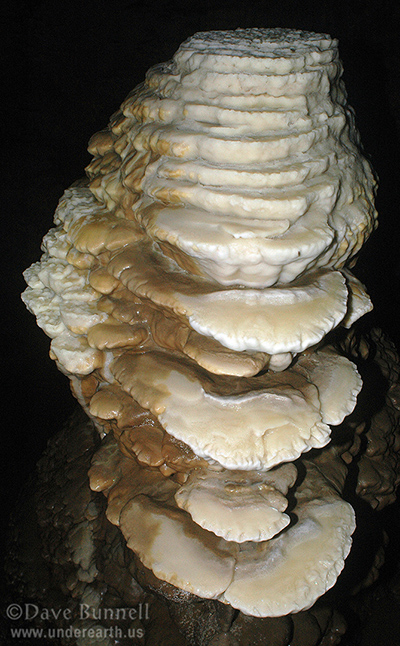
Speleothems are cave features formed by the deposition of minerals. The word itself comes from Greek “spelaion” which means “cave” and “thema” meaning “deposit”.
After the cave has been formed, the process of depositing secondary mineral features, also known as speleothems or cave formations, begins. This occurs through a chemical precipitation reaction between dripping water and mineralization processes, resulting in the creation of various beautiful decorations within the cave.
Speleothems can only be formed in dry caves, so the fact that we can observe them while diving means that all these caves were once dry. Some of the caves have been subsequently flooded as a result of changes in water levels at the end of the last Ice Age. We can see many different speleothems here during our dives, including stalagmites (which grow upward from the floor of caves), stalactites (growing downward from the roof of a cave), columns (when stalagmite and stalactite meet) and more.
Speleothems are not only beautiful features of many caves; they are also a valuable source of information to scientists. If you ever saw a broken stalactite in a cave, you can tell it clearly has a laminated structure similar to the layers inside a tree trunk. It is made up of several layers that have accumulated over time, the older layers being in the center.
Layers can be dated by measuring the decay of radioactive elements. The growth rate of stalactite and stalagmites depends on the amount of water dripping in the cave. This is influenced by rain. As a result, thin layers would indicate periods of drought and thicker layers would be an indication of heavier precipitation. The observation and analysis of speleothems can provide information on past global climatic changes and helps forecast current and future climatic variations, which is even more important as we’re facing global warming. The analysis of stable isotopes in speleothems can uncover past temperatures from oxygen trapped in the crystals, and also the types of vegetation, from trapped carbon, that occurred above the cave during the speleothems’ growth.
Stalactites, stalagmites and more…
The development of cave formations is influenced by the volume of water inflow and the partial pressure of carbon dioxide. Higher levels of carbon dioxide can lead to the formation of larger structures.
These formations often take on cascading arrangements, resembling flowstones.
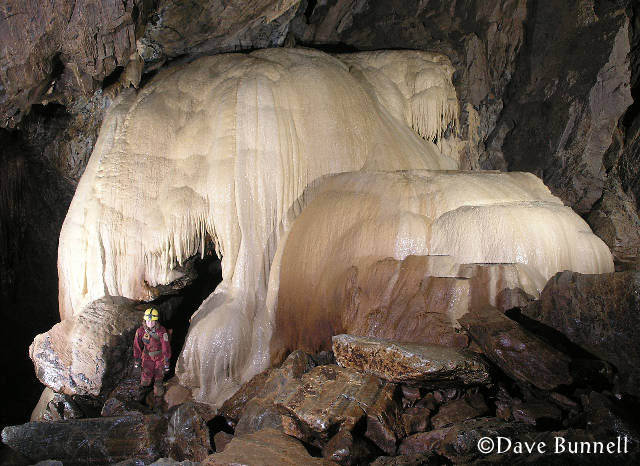
When the influx of water from cracks and holes in the ceiling of the cave decreases, it creates the conditions for the formation of massive, pagoda -shaped and palm-shaped stalagmites.
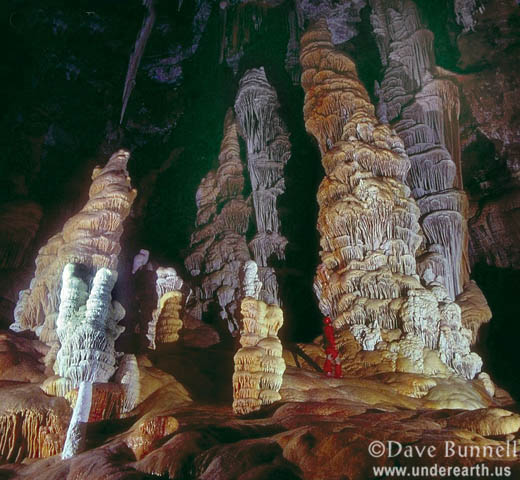
Stalactite formation starts with soda straws – thin, translucent tubes of calcite. A drop of water penetrates from the ceiling and hovers at the tip of a straw, depositing a ring of mineral at its edge. Eventually it falls and a new drop takes its place. Each drop deposits some more mineral before falling, and eventually a tube is built up. Stalagmites or flowstone may form where the water drops hit the cave floor. Soda straws are extremely fragile and can be broken with the slightest touch. You can see soda straws on cave ceilings, places like Cenote Dreamgate, some sections of Monkey Dust, and many others.
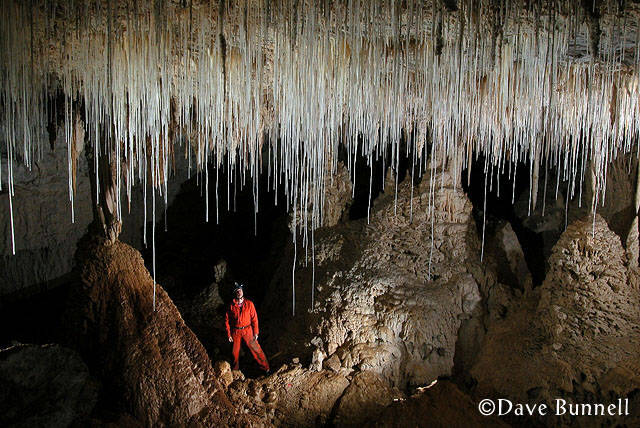
Further decrease in the influx of water saturated with calcium carbonate, creates conditions for forming conical stalactites and then stick stalagmites.
You can find a great variety of those in many cave systems here. My absolute favorite has to be Xulo and some sections of the Sac Actun cave system.
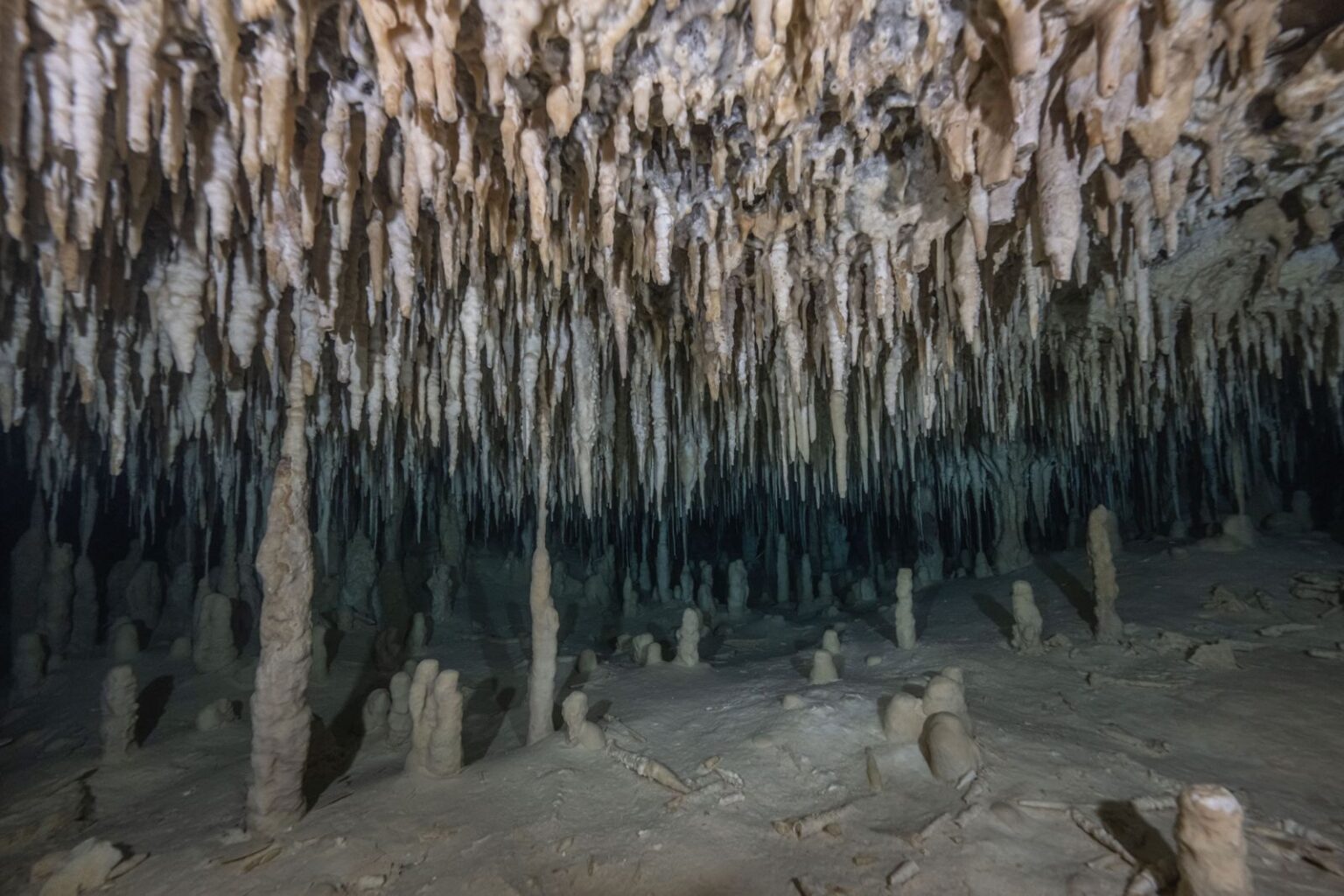
When stalactites and stalagmites grow big enough, they can meet and join. After they meet they are called pillars or columns. Columns are not really a different speleothem, they are the late stage of the stalactites and stalagmites formation.
You can see them diving in many places in Mexico – from the famous Swiss Syphon in Jail House to places like Calimba, Nariz and more.
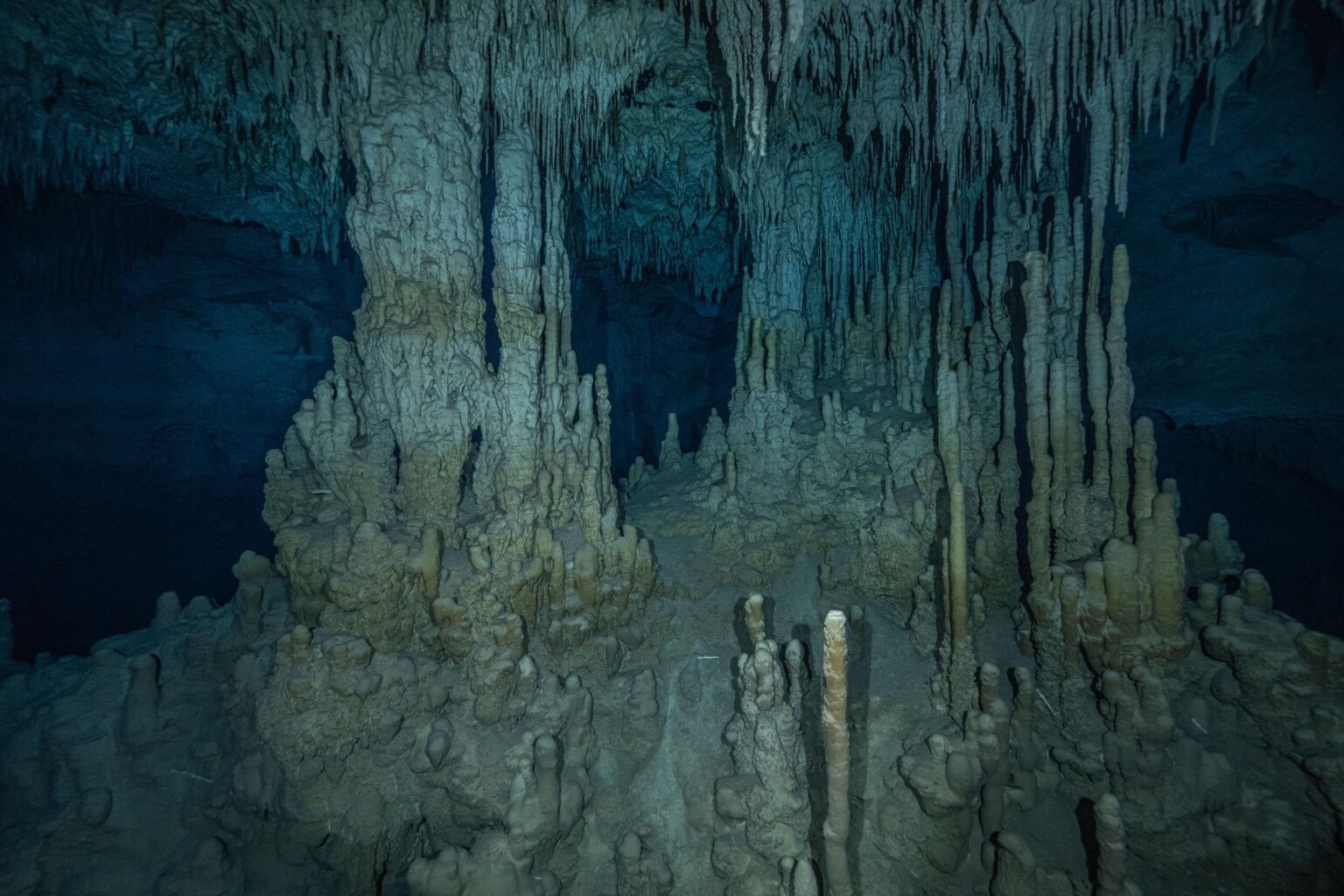
With negligibly small inflows of water, tubular stalactites are formed, as well as complex stalactites with a wide base.
At later stages of cave formation, the forces of crystallization start to dominate over the forces of gravity, which leads to eccentric stalactites formation, also known as helictites.
Helictites differ from classic speleothems as they grow with orientations that defy gravity. While there are different theories of how they’ve formed, helictites are the most beautiful cave formations, in my opinion.
A recent hypothesis is that they develop because a bacterial film provides a surface for the further mineralizations process that goes sideways.
Another theory says that they are most likely the result of capillary forces acting on tiny water droplets, a force often strong enough at this scale to defy gravity.
Helictites are, perhaps, the most delicate of cave formations together with soda straws, and can be easily crushed or broken by the slightest contact. They are usually made of needle-form calcite but can also be composed of aragonite. Helictite forms have been described in several types: ribbon helictites, saws, rods, butterflies,”hands”, curly-fries, and “clumps of worms”. My go-to place to show my divers a true helictite heaven would be one of the lines in cenote Nohoch Nah Chich.
When helictites are found on cave floors, they are referred to as heligmites.
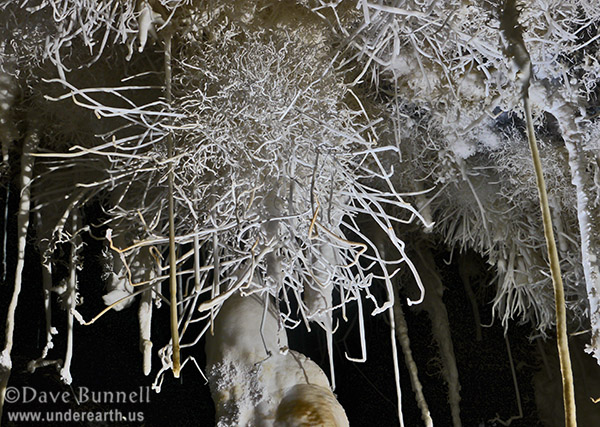
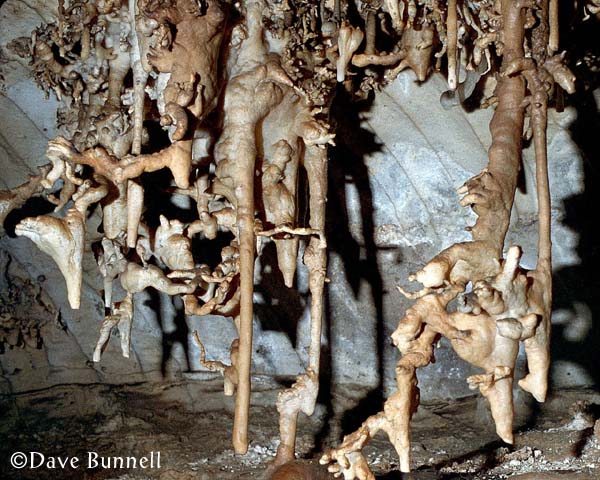
Some other common formations
Among other cave formations, there are Calcite rafts – a fine accumulation of calcite flakes floating on the water surface. When the water is oversaturated with calcite and evaporates it clogs these small rafts on the surface together. They eventually create a layer that becomes heavy enough to break, sink and settle on the bottom of the cave. When you see layers of thin calcite flakes on the cave floor, you can imagine they once were calcite rafts just like the one in the picture.
When water droplets flow down a sloped ceiling before dripping to the floor, calcite can build up in a slightly curved line. These lines gradually form so-called “draperies” or “cave bacon.” As the formations grow, small corrugation in the bedrock causes them to become curved. Over time the draperies become more accentuated and folded along their lower edges. At the bottom of draperies, if the curls have sharp edges, water droplets fall to the floor and may form flowstones.
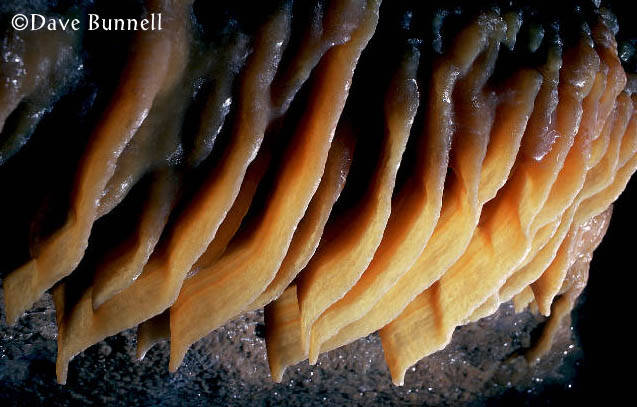
Moonmilk is formed from very fine crystals that vary in composition. Moonmilk’s particles dangle in water, which gives the deposit the appearance of milk. It is soft and pasty when wet, but becomes crumbly and powdery once dry. Wet moonmilk looks and feels very creamy; dry moonmilk brings to mind talcum powder if you touch it. Over centuries moonmilk has been used by our ancestors as a medicine: to stop bleeding, for fevers, diarrhea, and as an antacid. It can be found in flooded caves in a solidified form.
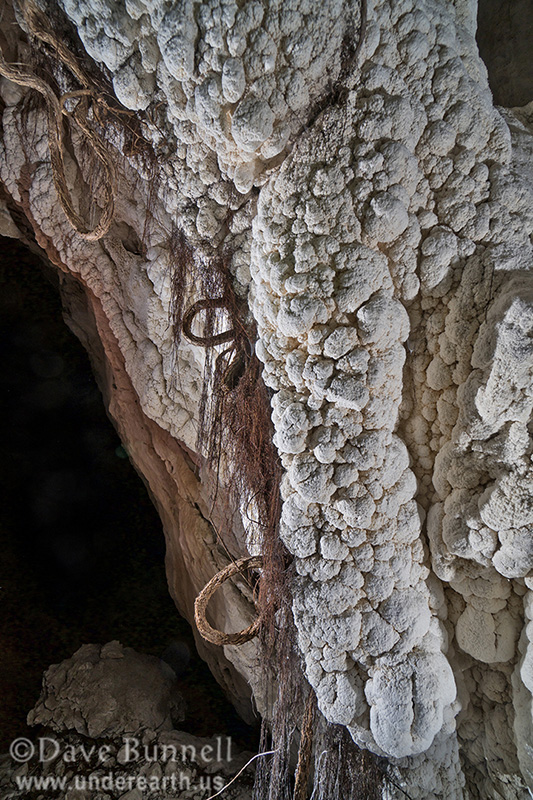
Coralloid, also known as cave popcorn, is an umbrella term describing corallike speleothems. They are probably the most common speleothems, and you can spot them everywhere. Coralloids range in size from tiny ones to giant masses a few meters in diameter. Some of them look like grapes, others like a cauliflower and are named accordingly.
Cave popcorn, a type of coralloid, is formed by precipitation and evaporation, and often it looks like an edible popcorn.
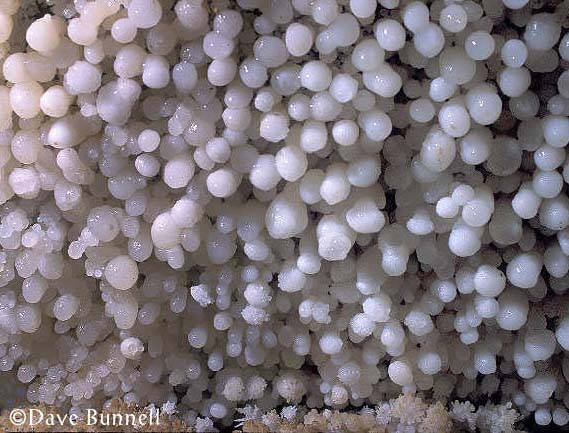
Cave pearls, another cool looking formation, form in shallow cave pools on the cave floor. They vary in shape and can be spherical, cylindrical, cubical, or even hexagonal. Cave pearls have been compared to marbles, oranges, pigeon’s eggs, balls, and most of all, pearls from where their name comes from.
Cave pearls normally grow where water is dripping in from above or slowly flowing into the pool. Carbon dioxide is lost to the air, carbonate material settles around bigger particles in the pool and excess material coats the floor and builds up into cups or nests around the pearls. Many materials may act as nuclei for cave-pearl growth, such as bat bones, sand grains, shell fragments and even pieces of soda straws. All of these fragments become rounded as they grow into cave pearls of different shapes. The best one I’ve seen is one of the passages of Xulo and some parts of Dos Ojos.
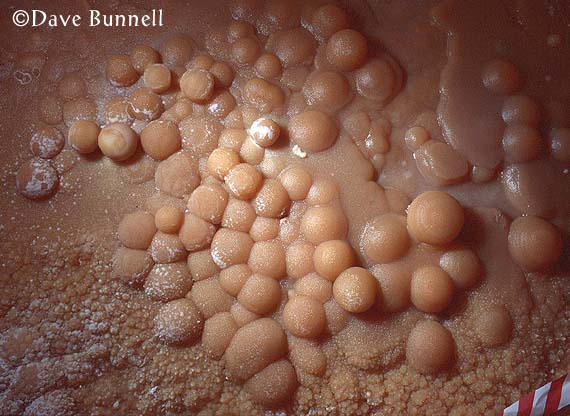
Cave Sediments
Most people never give any thought to the sediments they walk on, yet cave sediments are often the only or main evidence of how the surface landscape has evolved through the cave formation era.
Caves act as traps for sediment. They accumulate various particles of inorganic and organic materials. In caves, where water flows underground from the surface, various types of sediment are deposited, including gravel, sand, clay and clay soil. The transport of these sediments can mechanically enlarge karst caves by scouring the walls and floors, and significantly transforming cave channels. In some instances, sediment can also protect caves from further erosion and create so many layers of sediment that the original cave shape would be completely covered.
Next time when you dive above the cave floor, just imagine how the sediment on the bottom has been washed little by little over thousands of years, to create the present landscape.
All this makes it truly devastating to see inscriptions or hearts drawn on the floor of the cave by divers who clearly don’t understand the value of cave conservation and what it means to be a responsible cave diver. Hopefully, educating more cave divers on the matter will make a positive change on that front.
Of course, this is not the full list of the cave formations you can find around the world, otherwise this article would’ve been way longer.
Some cave formations to this day take my breath away and leave me with a question: “How did this happen”?! The more I learn about how they are formed the more I realize how much we still don’t know about the geology and the cave forming processes. Compared to the formation of caves and the growth rate of stalactites, human life seems instantaneous. It sometimes makes me feel like a grain of sand in space as I swim by not only past something so ancient, but actually inside such an old structure. Maybe, this is one of the reasons I love cave diving so much – it gives you a chance to touch history.
I would like to thank Dave Bunnel who kindly gave his permission to use his brilliant pictures for the article. In case you haven’t heard about Dave, he has been a caver and a cave photographer for more than 40 years. He is the Editor of the “NSS News, America’s Caving Magazine” and has won numerous awards for his work. His photographs have been published in more than 30 books and in hundreds of articles.
And, of course, huge appreciation goes to Alvaro Herrero, our in-house genius, for taking yet another set of wonderful pictures.
